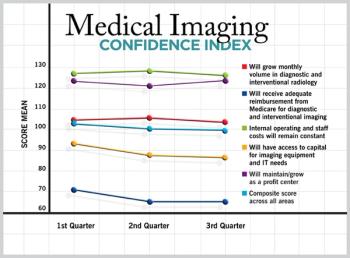
The radiology field will soon have a professional development and leadership academy. Next year, the American College of Radiology will open the Radiology Leadership Institute, a multi-level academy that will offer leadership courses and activities.

The radiology field will soon have a professional development and leadership academy. Next year, the American College of Radiology will open the Radiology Leadership Institute, a multi-level academy that will offer leadership courses and activities.

Cuts to reimbursement payments are looming thanks to health care reform measures. No doubt, they have you and other specialty providers scrambling to identify strategies to compensate for the lost revenue.

Should the process be scrapped? Vote here, and tell us what you think.

In an unexpected move, the IOM called for an end to the 510(k) clearance process that has been under revision for the past year and proposed that Congress enact legislation for a new regulatory system after the FDA determines how to create one. The 510(k) process is the current pathway that authorizes low-risk medical devices, including those for imaging.

Like many others, we are now exploring how radiologists may benefit from the EHR incentive program. Our interest is sparked by the fact that for all physicians, CMS will pay cash incentives to eligible health care professionals who make “meaningful use” of certified EHRs. But maybe even more eye-opening is the fact that those who are eligible but don’t meet the requirements will find CMS payments reduced starting in 2015.


Medical imaging managers continue to have low confidence that reimbursement rates will improve in the near future and that funding for capital purchases will become readily available.

Once programmed for radiology, this technology will save time and will be a handy assistant, but first PACS vendors must get on board with health records integration.

The FDA issued draft guidance July 7 to exempt 19 types of radiology device accessories from premarket notification requirements. Among the devices include film cassettes, film processors and digitizers.

“Significant and unwarranted” medical imaging cuts in the Proposed Medicare Fee Schedule Rule for 2012, on top of “extreme” cuts to imaging services over the last five years, will drive many imaging providers from practice, restrict access to care, even for procedures not specifically affected by the cuts, and may actually increase Medicare costs for many of these services, the American College of Radiology said Tuesday.

Non-radiologists – physicians or otherwise – with on-site imaging services are two-and-half times more likely to order imaging than clinicians with no financial interest in imaging.

NEC Display Solutions of America announced this week the Food & Drug Administration 510(k) market clearance of the 30-inch MultiSync MD301C4 medical diagnostic display for the displaying and viewing of digital images for diagnosis.

The University of Chicago has acquired technology and intellectual property rights for the development of amifostine, a drug researchers hope can prevent genetic changes caused by a variety of sources of ionizing radiation exposure, including common Computer Tomography (CT) scans.

There are many vendors that provide supplies for our imaging needs. I doubt that any of them would object to accepting more money from you if you are willing to pay it. The task lies within you and your organization to find the savings.

On October 1, 2013, every radiology practice has to start using the International Classification of Disease 10 (ICD-10), instead of ICD-9. This will bring immense complications for radiologists in their billing and payment procedures. Is ICD-10 beneficial, a bureaucratic burden, or a bit of both? And, in any event, what are the best measures you and your staff can take to prepare?

There are few buzzwords likelier to get a strong reaction from radiologists than the one mentioned above. Bring it up, and folks can get animated, agitated, or downright angry. Part of what makes this such a tinderbox is that “teleradiology” refers to a heterogeneous group of entities, and it’s easy to dismiss them all with a single condemning sweep of the hand.

Advice from Andy Savo on negotiating the new marketplace

Hundreds of hospitals across the country needlessly exposed patients to radiation by giving patients doubled-up CT chest scans a front page article in Saturday’s New York Times found.

Today, the Medicare Payment Advisory Commission (MedPAC) recommended that Congress require pre-authorizations for some imaging services, consistent with its proposed recommendations from last month.

A bipartisan bill to set minimum education and certification standards for technical personnel providing, planning and delivering Medicare-funded medical imaging and radiation therapy treatments is moving through Congress.

How teleradiology is leveraging the cloud computing trend -- and doing it differently than non-healthcare companies

The median starting salary for diagnostic radiologists in 2010 was $350,000, according to the just-released Placement Starting Salary Survey: 2011 Report Based on 2010 Data from the Medical Group Management Association.

Boost your patient satisfaction and streamline your workflow with these top five tips.

Accrediting organizations urge providers to apply by June 30, 2011. On the first day of 2012, private outpatient imaging centers providing MRI, CT, PET exams and nuclear medicine procedures will need accreditation for Medicare to reimburse for the technical component under Part B of the Medicare Physician Fee Schedule.

Yes, part of radiology service is accommodating what seem like demanding requests sometimes. But each call, be it from physician or patient, needs to be handled professionally, quickly and efficiently.